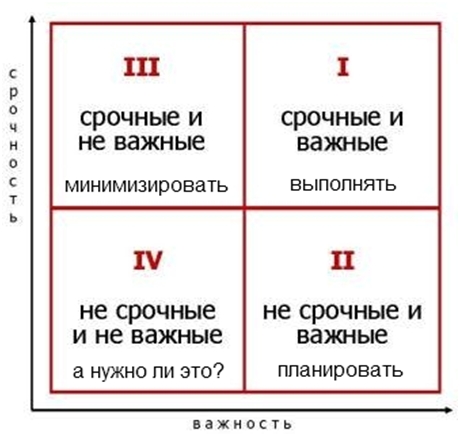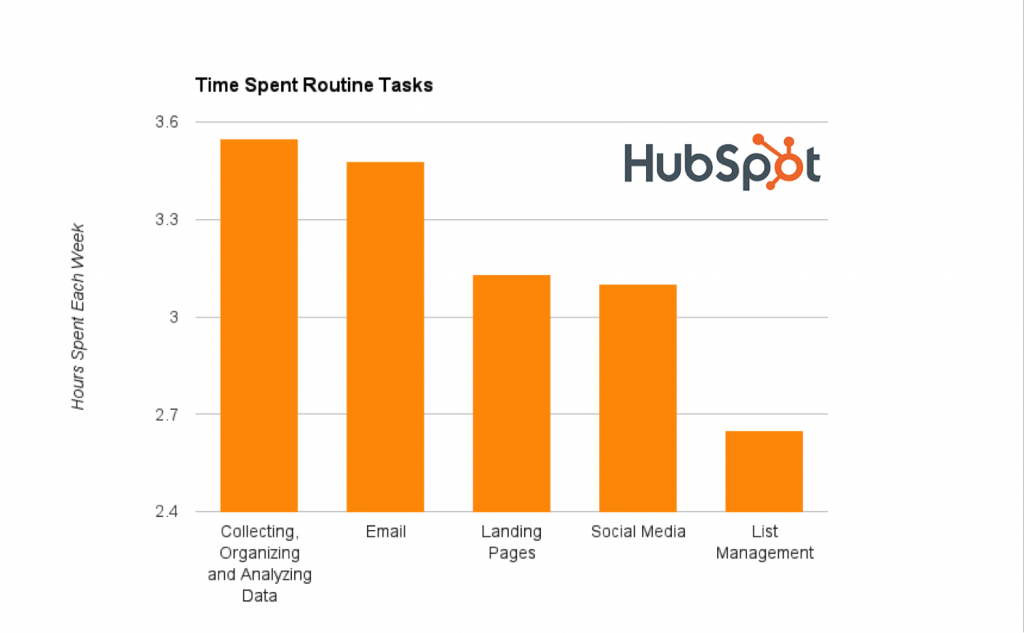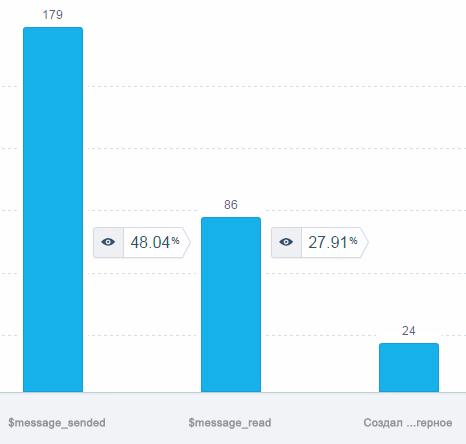How routine tasks can kill a marketing career and his company's profit. Action plan

“But isn’t I losing too much time and money on all this?” Let’s see how marketers spend time and what tasks only move them away from the main goal.
For marketers, this is not just a question. This is the main pain of the marketer, because wasting time on trifles (which can be done much faster), we do not leave time to solve important, but not urgent tasks, and they are the main contribution to the growth of the specialist and his company.
To understand how effectively you spend your time, it is worth taking a look at the Eisenhower matrix (urgency and importance of tasks).

Typically, all marketers fall into a time-trap and spend their key time on Square 1 (urgent and important matters) and Square 3 (wasting time on not-so-important tasks). If you had a day in square 1, you were tired, but it was nice. After all, you coped brilliantly with the hands and were on top in a difficult moment. Succeeding in square 1, you feel great, but there is a catch. All this is routine, it practically does not bring you closer to key goals.
The most important is square 2, the tasks in which are not so urgent, but much more important than in square 1. You must allocate time for them, but how can this be done if all your time is spent on solving the problems of square 1? How to free up your time for really important things?
For example, such as preparing a large advertising campaign, developing a content marketing strategy, preparing a publication plan, etc. Sam Bolter, a HubSpot marketer, like all of us, always asked himself this question, “how much time do I spend on routine”. He decided to conduct a study of how much time the routine actions of a marketer take. For example, writing a letter, forming a list of users for distribution, data analysis, etc. He did a simple survey, which outlined the 5 main routine actions of marketers.

- Formation of a list for distribution;
- Monitoring, tracking and analysis of social media;
- Creation and distribution of letters;
- Building Landing;
- Collecting, organizing and analyzing data.
Well, how much time does the marketer spend?
On average, a marketer spends about 16 hours a week on routine tasks, and that's 40% of the time. It turns out that almost each of us spends more than a third of our time on monotonous and repetitive tasks, the costs of which need to be minimized.
Let's see what tasks take the most time: creating and sending letters (almost 4 hours) + collecting and analyzing data (also almost 4 hours). As for the remaining tasks, they almost keep up with the leaders. Time for a routine: 1 - Data collection and analysis; 2 - Formation and sending letters; 3 - Work with landings; 4 - Social Media; 5 - Formation of a list for distribution and segmentation.

Yes, routine work cannot be avoided, but it is worth trying to reduce the time spent on this. In other words, you can make the routine not occupy 40% of your time, but only 20-25%.
The formula for saving time will look something like this:
Saved Time per Year = [Time for Routine Now - Time for Routine Future] * 52
SVG = (16 hours - 10 hours) * 52
SVG = 262 hours per year
260 hours per year. 260 free hours to work on your key goals. 260 hours for something else: website redesign, learning new tools, new advertising campaigns, attending trainings, etc. Saving time on a routine gives more time for your initiatives and reflection on your work.
3 tips to save even more time
Each marketer is not like the other. Working conditions, available technologies, team size, marketing structure in the company - everything is of great importance if you want to save time. But if you focus on simplifying, delegating and even getting rid of routine tasks, you can cheat and “cut the road”.
Since mailings and analytics take up the most time, we will focus on them in more detail.
Tip # 1: Identify the Most Important Metrics
Want to reduce the amount of data you collect for analytics? Just stop tracking metrics that neither you nor your team need. As it usually happens, the marketer does not know what to focus on and monitors all-all indicators.
Here is an article in the topic about which metrics to use at different stages of project development .
If the “average time spent on the page” is being monitored, then yes, this is undoubtedly very interesting statistics, but if it does not make any difference to your decisions or strategy, then remove it from your weekly report. Keeping track of unnecessary metrics devours time and energy that you could spend on something more important.
Tip # 2: Connect Effective Services
Due to the large number of Internet marketing services, it is quite difficult to receive reports on each of the metrics and, in general, to build Internet marketing processes. The problem is that around us there is a complete zoo of services, you need to spend time on all of them and somehow integrate them with each other (most often manually).
Here is how it looks. In a separate service, the marketer maintains a user base together with a sales department (CRM system), in another analyzes the landing pages and visitors to them, in the third one monitors key performance indicators, in the fourth one exports user bases from CRM and makes mailings, etc. . This is wasting our time to the maximum and does not allow us to engage in real marketing.
We did not want to put up with this, therefore, we created the Carrot Quest serviceWhich has integrated key internet marketing tools. Only on this you can free up to 10 hours a week (once spending 4-5 hours on setting).
Tip # 3: Moderate Your Creative
The next pain for marketers is email newsletters.
How to save time here? The whole problem is imagination and creativity when creating the appearance of the letter and its texts. Believe me, in newsletters, super-duper design only reduces their effectiveness. As it turned out, letters with a simple design are best read and converted. Letters that look like letters from friends, colleagues, and friends. Yes, it sounds unusual, but it does. Stop wasting time on letter design, use the simplest and most effective templates. Every day, users send mountains of letters with a “wow” design to spam.
You will see for yourself when you start to analyze your mailings in detail in Carrot Quest. No, no, I'm not talking about the openness of the letter (open rate) or clicking on the links (click rate), but about more detailed metrics when you know how the letter affected the target action of the user.
Here is an example of such an analysis of an email newsletter:
We sent an email newsletter with the Lesson " Personal trigger email marketing on the example of an abandoned order ." It makes no sense to estimate the number of clicks on the link in the letter, because the user can decide on the action now, as well as in a week and can’t be tracked by standard metrics.
It is important to know whether the target action was completed after reading the letter (after all, the user can complete it in 10 days, and the click rate here is just not an assistant). The purpose of this newsletter is to create a trigger message in the service. Of the 86 who read, 28% reached the target action. Good rate. Appreciate your time and pay attention to what square of the Eisenhower matrix you find. Remember, square 2 is a contribution to your success, career and company profit. And what tasks do you devour the most time? What would you do if you had 260 extra hours? Share your thoughts in the comments. With pleasure, the Carrot Quest team

- a service that knows all the information about each user on your site and, taking into account this knowledge, allows you to increase the conversion to the first and repeated sales (via chat, pop-up or email)
Some of the material was taken from hubspot.com
